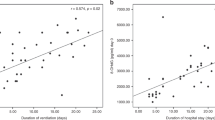Abstract
Objective
To study the serum levels of oxidative stress markers — malondialdehyde (MDA) and protein carbonyl in babies with perinatal asphyxia and to correlate their levels with the outcome in terms of mortality and neurodevelopmental sequelae.
Methods
A group of 40 term AGA (appropriate for gestational age) infants with perinatal asphyxia were selected as cases and same number of healthy babies as controls. Serum levels of oxidative stress markers — malondialdehyde and protein carbonyl were determined in cord blood and at 48 hours of life. Their levels were correlated with the outcome of perinatal asphyxia in terms of mortality and the long term neurological outcome.
Results
MDA and protein carbonyl, in cord blood were significantly higher among cases (5.88±1.40 μmol/L and 1.50±0.48 nmol/mg of protein respectively) than controls (3.11±0.82 μmol/L and 0.83±0.19 nmol/mg of protein respectively). Among the cases, MDA and protein carbonyl values at 48 hours of life (7.52 ± 1.06 μmmol/L and 2.91 ± 0.62 nmol/mg of protein respectively) were significantly higher than those at birth. MDA at birth and 48 hours was significantly higher among babies who had seizures than those who remained seizure free. These values were also significantly higher in babies who expired as compared to those who survived. Protein carbonyl values though higher in those who had seizures and in those who expired, were not statistically significant from controls. MDA and protein carbonyl at birth and 48 hours were higher in babies with developmental delay but the association was not statistically significant.
Conclusions
In hypoxic ischemic encephalopathy (HIE), oxidative stress markers MDA and protein carbonyl are high at birth and rise further at 48 hours and the values correlate with the morbidity and mortality. Therefore, determining the serum levels of oxidative stress markers MDA and protein carbonyl will be of benefit in predicting the outcome in perinatal asphyxia.
Similar content being viewed by others
References
National Neonatology Forum NNPD Network. National Neonatal-Perinatal Database Report 2002–2003. New Delhi, Jan 2005.
Banupriya C, Ratnakar, Doureradjou P, Mondal N, Vishnu B, Koner BC. Can urinary excretion rate of malondialdehyde, uric acid and protein predict the severity and impending death in perinatal asphyxia? Clinical Biochemistry 2008; 41: 968–973.
Satoh K. Serum lipid peroxide in cerebrovascular disorder determined by a new colorimetric method. Clin Chim Acta 1978; 90: 37–43.
Levine RL, Williams JA, Stadtman ER, Shacter E. Carbonyl assays for determination of oxidatively modified proteins. Methods Enzymol 1994; 233: 346–357.
Phatak AT, Khurana B. Baroda development Screening test for infants. Indian Pediatr 1991; 28: 31–37.
Thorat VN, Suryakar AN, Sardeshmukh AS, Sarawade SS. Oxidants and antioxidants in hypoxic ischaemic encephalopathy. Indian J Clin Biochem 2004; 19: 32–35.
Singh SK, Dua T, Tandon A, Kumari S, Ray G, Batra S. Status of lipid peroxidation and antioxidant enzymes in hypoxic ischemic encephalopathy. Indian Pediatr 1999; 36: 659–668.
Bhatia BD, Goel A. Study of free radicals in neonates born through meconium stained amniotic fluid deliveries. Indian Pediatr 2005; 42: 956–957.
Žitňanová I, Šimko M, Sumegová K, Korytar P, Maruniaková A, Demelová D et al. Markers of oxidative stress in umbilical cord blood in hypoxic newborns. J Ped Neonat 2004; 1: NT1–NT4.
Brucknerova I, Benedekova M, Pechan I, Frankova E, Ujhazy E, Dubovicky M. Influence of oxidative stress on liver cell function on 1st and 5th day of life in asphyxial newborns. Biologia Bratislava 2005; 60: 25–28.
Author information
Authors and Affiliations
Corresponding author
Rights and permissions
About this article
Cite this article
Mondal, N., Bhat, B.V., Banupriya, C. et al. Oxidative stress in perinatal asphyxia in relation to outcome. Indian J Pediatr 77, 515–517 (2010). https://doi.org/10.1007/s12098-010-0059-4
Received:
Accepted:
Published:
Issue Date:
DOI: https://doi.org/10.1007/s12098-010-0059-4




